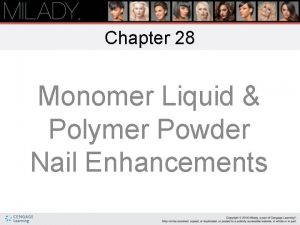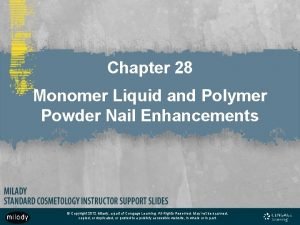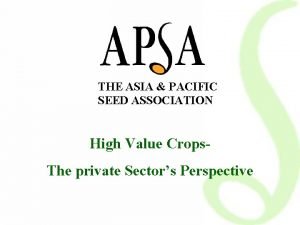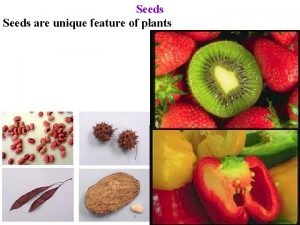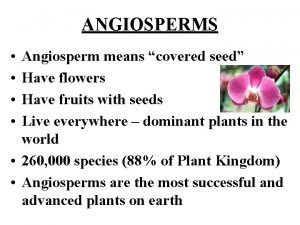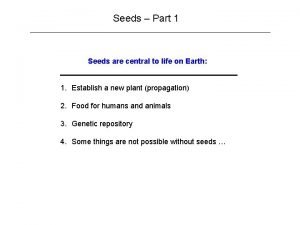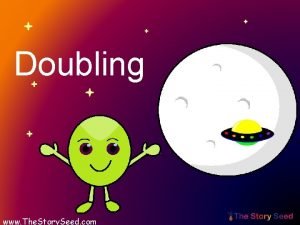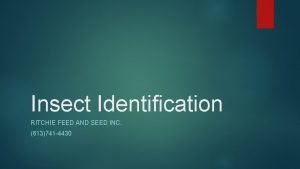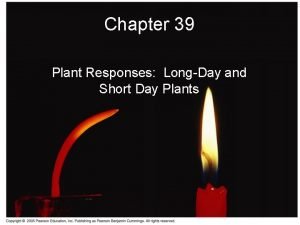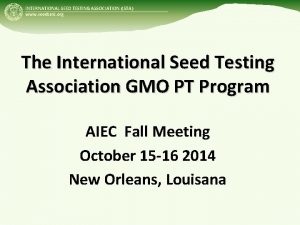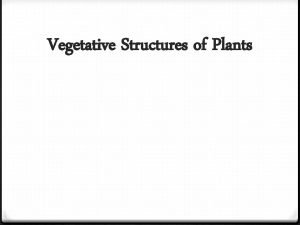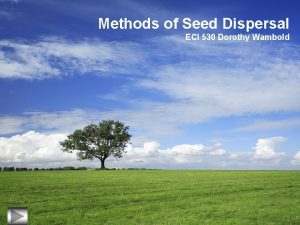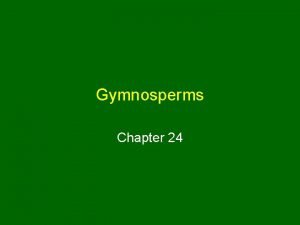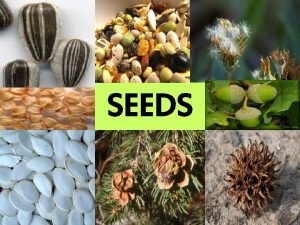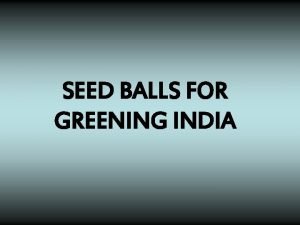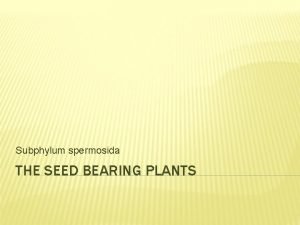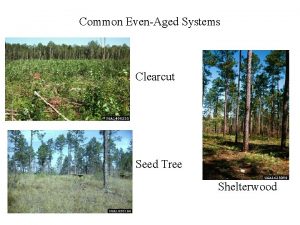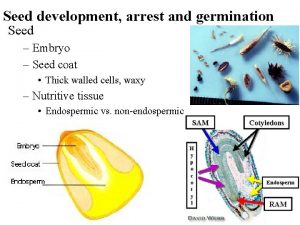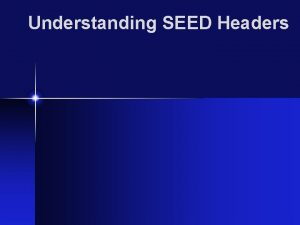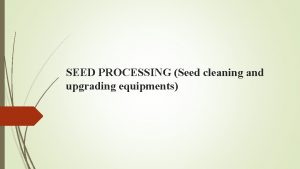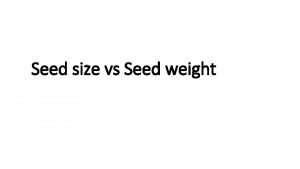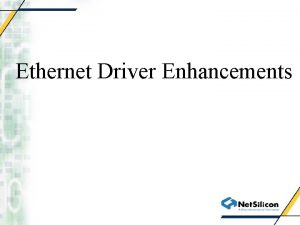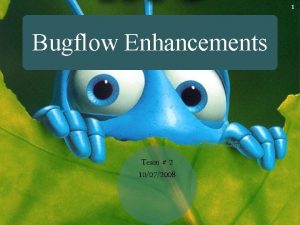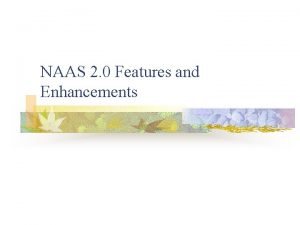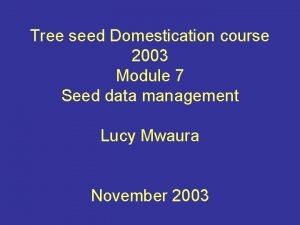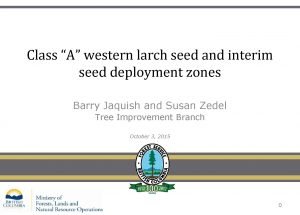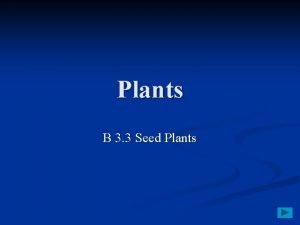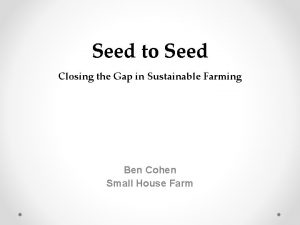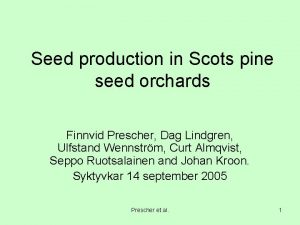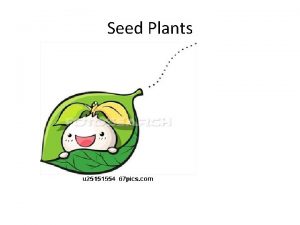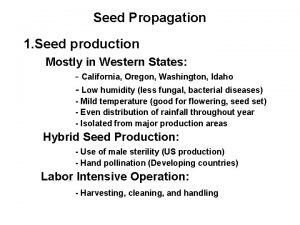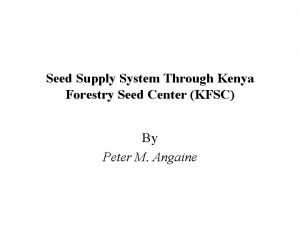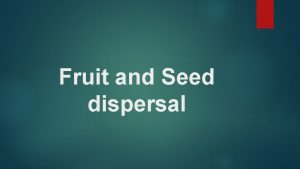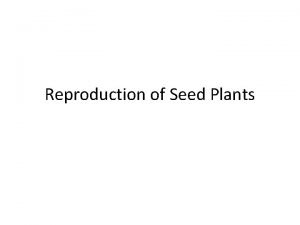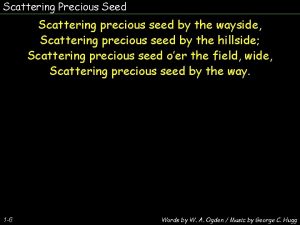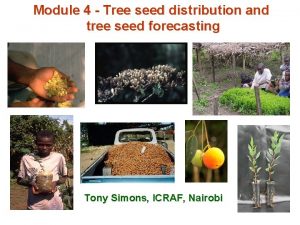Seed enhancementDefinition Seed invigoration or seed enhancements are

































- Slides: 33


Seed enhancement-Definition Seed invigoration or seed enhancements are “post-harvest” treatments to improve germination and seedling growth or help in the provision of seeds and other materials required at the time of sowing. (Taylor et al. , 1998)

Seed enhancements objectives ØImprove germination/seedling growth through manipulation of seed vigor or physiological status üHydration trts (priming, steeping, hardening, pregermination). ü Chemicals to trigger stress tolerance. ü Antioxidants Ø Facilitate seed planting (pelleting, coating, encrusting). ØDeliver materials needed at sowing (e. g. nutrients, inoculants).

Cont…… ØRemove weak or dead seeds using nontraditional ‘upgrading’ techniques (density, color sorting etc). ØBetter adaptation to less than optimum conditions crops can compete more effectively with stresses and weed. Ø ‘Tagging’ of seeds with visible pigments or other Materials for traceability and identity Preservation.

Wh y. T See reat ds?

Why Treat Seeds? ØHigher yield ØOften pays for itself ØImproved crop quality ØA safeguard against disease ØPest protection with lower environmental impact ØA smart way to apply anti-pest products ØSmooth machinery operation ØEasier handling

Seed Enhancement Thermal treatment Dry heat treatment Pre-sowing Chilling Hydropriming On farm priming Coating / pelleting Priming Hardening Osmopriming Osmohardening Matripriming Hormonal priming Humidification

Thermal Treatments A. Heat Treatments ØControl the external and internal seed-borne pathogens, including fungi, bacteria, viruses, and nematodes (Nakagawa 1989; Fourest et al. , 1990). Ø Break the dormancy of seeds (Zhang, 1990; Dadlani and Seshu, 1990).

Cont…. . B. Pre-sowing chilling ØAlso called cold stratification. ØCold treatment releases the dormancy and enhance plant tolerance to salt stress. Ø The beneficial effects of cold stratification could be attributed to ionic homeostasis and hormonal balance (Sharma and Kumar, 1999; Iqbal and Ashraf, 2007, 2010)

Seed priming

Seed priming: (A simple low cost solution) ØSeeds are hydrated in a controlled manner to provide enough water to initiate the metabolic processes of germination, but not enough to allow germination to be completed. ” ØImprovements in germination speed and/or uniformity common with primed seed lots.

Hydropriming Ø Seed soaking in tap water (with or without aeration) and re-drying to original weight (Soon et al. , 2000, Farooq et al. , 2006). Ø No chemical is used. Ø Environmently safe

A. On-Farm Seed Priming ØFarmers can prime their own seeds. ØSeeds are soaked in clean water, usually overnight (about 812 hours). ØAfter soaking, the water is drained off and the seeds are surface-dried by placing them on a cloth or plastic sheet on the ground for 15 to 30 minutes.

Soaking Period Recommended safe limits tested in over 100 farm trials (with only minor differences depending on variety and country) include: ØRice: 24 hours ØWheat and Barley: 12 hours ØUpland Rice and Maize: 16 to 18 hours ØSorghum and Pearl Millet: 10 hours ØChickpea and Mungbean: 8 hours

B. Hardening Repeated soaking of seeds in (aerated) water and re-drying. This hydration-dehydration cycle may be repeated twice, thrice and so on (Lee and Kim, 2000, Farooq et al. 2004).

Osmopriming (osmoconditioning) ØSeeds are incubated in well aerated solutions with a low water potential, and afterwards washed and dried. ØPEG is preferred osmoticum due to large molecular size and inert form which precludes it from being taken up by the embryo.

Halopriming ØSoaking of seeds in salt solutions was proposed as alternative to priming which enhanced germination and increase seedling emergence uniformity under adverse environmental conditions. ØCommonly using salts are Na. Cl, KNO 3, Ca. Cl 2.

Hormonal priming Soaking of seeds in an appropriate concentration of hormones (GA, Auxin, Kinetin, Salicylic acid) before radicle protrusion.

Matrix priming (Matriconditioning) Ø “Incubation of seeds in a solid, insoluble matrix (vermiculite, diatomaceous earth) with a limited amount of water. ” Ø Solid matrix carriers e. g. Micro Cell. E®, Celite, Press mud, Jute mat, Peat soil, compost

Seed Priming Effects on Germination Rates Seed priming generally reduces the time to radicle emergence and the spread in time over which germination occurs.

Seed Coating

Coating ØApplication of materials to the seed surface, often containing seed protectants such as fungicides. Ø A major advantage of film coating is reduced loss of active material from the seed during seed transport and handling.

Seed Pelleting

Seed Pelleting ØInert materials are added to change seed size and shape for improved plant ability. ” Ø Used to round out small or irregular shaped seed, or to make small seeds larger – improves singulation and speed of sowing.

Cont…… ØSeed in rotating drum is wetted, and blends of powdered materials (e. g. chalk, clays, perlite, lime, peat, talc) plus water-attracting or hydrophobic materials are progressively added, along with more water, until desired pellet wt or size increase is achieved. Ø Wet-coated seed then dried with air, usually in separate equipment.

Encrusting ØAddition of a small amount of material to a seed to enable accurate mechanical seed metering. Ø Encrustment is most often used on crops that benefit from seed singulation but don’t require post-emergence thinning. ØEncrusting adds more weight to the finished product than film coating and significantly less weight than pelleting. ØApply a minimum amount of filler materials and binders, whist still increasing the size of the seed, and filling out any irregular shapes and surfaces.

Pelleting vs. Encrusting ØEncrusting (aka ‘minipelleting’ or ‘coating’) applies less material, So the original seed shape is still(more or less) visible. Ø When the added material is slight, the product may appear similar to film coated seed. Ø Seed pelleting and encrusting techniques were commercially developed in the past 4050 years, using techniques from confectionery and pharmaceutical industries.

Film coating, Encrusting & Pelleting

Pre-germination ØSome seed enhancement technologies permit early germination to occur prior to sowing. Ø Sprouted seeds are suspended in a gel, and sown by extrusion. ØFluid drilling is one of these techniques

Cont…… ØFully imbibed seeds germinated to point of visible radicles, then sorted and gradually dried to induce desiccation tolerance. Ø Can produce damp pre-germ seeds with storage life of a few weeks at ambient temps, or dry pre-germ seed (viable for a few months). Ø Commercially available at present for high-value flower seeds only (e. g. Impatiens, pansy)(Halmer, 2006)

Conclusion ØImprove seed sowing, germination and seedling growth by altering the physiological state of the seed. ØImprove vigor or the physiological state of the seed by enhancing uniformity of germination. ØEnhance disease resistance in seeds. ØEnhance seed vigor and modify seed emergence capabilities. ØThe seeds pelleted with different chemicals recorded significantly higher growth parameters over unpelleted seeds. Ø Precise placement on the target. ØMinimum toxicant used. ØMinimum environmental impact. ØMinimum wildlife and other organism exposure.


 Antigentest åre
Antigentest åre When using monomer liquid and polymer powder, you:
When using monomer liquid and polymer powder, you: Traditionally light cured gels relied on
Traditionally light cured gels relied on When using monomer liquid and polymer powder
When using monomer liquid and polymer powder Advertising vs promotion
Advertising vs promotion Which part of the plant carries and protects the seed
Which part of the plant carries and protects the seed Asia pacific seed association
Asia pacific seed association Seed maturation
Seed maturation What is breeder seed
What is breeder seed Angiosperms
Angiosperms Lasor seed
Lasor seed Magnoliids
Magnoliids Monocot seed
Monocot seed The story of a seed
The story of a seed Ritchie feed and seed
Ritchie feed and seed Parts of a seed
Parts of a seed Observation of seed germination day by day
Observation of seed germination day by day Seed germination
Seed germination Seedtest.org
Seedtest.org What does mitch represent in a streetcar named desire
What does mitch represent in a streetcar named desire Genesis all seed bearing plants
Genesis all seed bearing plants Primary root and secondary root
Primary root and secondary root Beggar ticks seed dispersal
Beggar ticks seed dispersal Ecological importance of gymnosperms
Ecological importance of gymnosperms Tomato seed dispersal
Tomato seed dispersal Monocot seed
Monocot seed Seed balls in india
Seed balls in india Md zahidul islam chowdhury
Md zahidul islam chowdhury Pawnee seed preservation project
Pawnee seed preservation project Life cycle of seed bearing plants
Life cycle of seed bearing plants Seed tree system
Seed tree system Isolation distance
Isolation distance Scarification and stratification of seed
Scarification and stratification of seed A small, hard, dry seed harvested for human consumption.
A small, hard, dry seed harvested for human consumption.

